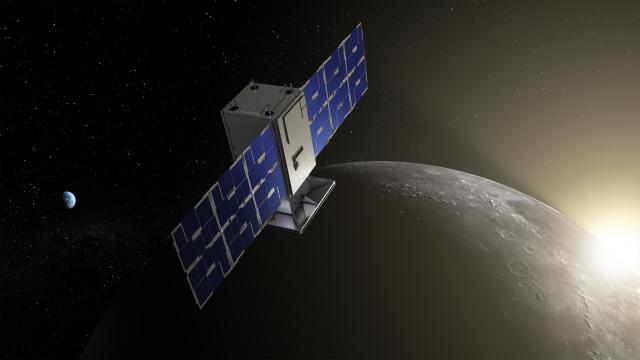NASA and its partners are seeking to build a lunar space station later this decade as part of the ambitious Artemis program, but before that can happen, a microwave-sized probe will need to perform important duties in a unique and promising lunar orbit.
Should all go as planned, the CAPSTONE satellite will launch later this month, and become the first human-built device to operate in a near rectilinear halo orbit (NRHO). Zooming around this highly elliptical orbit, the 25-kilogram cubesat — owned and operated by Colorado-based Advanced Space — will drift some 76,000 km from the Moon’s north pole, but come to within 3,400 km of the opposite pole during its closest approach. A full orbit takes around one week.
Models suggest NRHO is ideal for spacecraft as it will require less fuel than “conventional” orbits, while also allowing for constant contact with Earth. NASA describes it nicely: “This pathfinding CubeSat will practically be able to kick back and rest in a gravitational sweet spot in space — where the pull of gravity from Earth and the Moon interact to allow for a nearly-stable orbit — allowing physics to do most of the work of keeping it in orbit around the Moon.”
Not coincidentally, this is the orbit of choice for the upcoming Lunar Gateway, an orbital outpost that will enable NASA and its partners to establish a long-term presence on the Moon. This orbit would have the added benefit of “allowing Gateway to have optimal communications with future Artemis missions operating on the lunar surface as well as back to Earth,” Elwood Agasid, deputy program manager of Small Spacecraft Technology at NASA’s Ames Research Centre, said in an agency release. “This could unlock new opportunities for future lunar science and exploration efforts.”
This $US13.7 ($19) million NASA-funded mission, formally known as the Cislunar Autonomous Positioning System Technology Operations and Navigation Experiment, is a confidence check to see how spacecraft fare in this orbit, and to also test an autonomous navigation system developed by Advanced Space. Other private NASA partners for the CAPSTONE mission include Tyvak Nano-Satellite Systems, which is responsible for the cubesat platform, and Stellar Explorations, which is providing CAPSTONE’s propulsion system.
CAPSTONE is expected to launch later this month atop an Electron rocket, which will depart from Rocket Lab’s Launch Complex 1 in New Zealand. Rocket Lab made headlines earlier this month by using a helicopter to catch a falling rocket booster, but this launch represents a new challenge, as it marks the company’s first attempt at launching a payload further than low Earth orbit. The mission will also see the first use of Rocket Lab’s Photon second stage, which will send the cubesat on its trajectory towards the Moon. CAPSTONE will circle Earth in increasingly widening orbits until it achieves a transfer orbit with the Moon, in a journey that will take roughly four months to complete.

“CAPSTONE will be precisely controlled and maintained and will benefit tremendously from the nearly-stable physics of its near rectilinear halo orbit,” said Agasid. “The burns [a series of “clean-up” manoeuvres] will be timed to give the spacecraft an extra boost as it naturally builds momentum — this requires a lot less fuel than a more circular orbit would require.”
Models suggest NRHO is ideal for spacecraft, but CAPSTONE “will help reduce risk for future spacecraft by validating innovative navigation technologies and verifying the dynamics of this halo-shaped orbit,” according to NASA. Indeed, a lunar outpost in NRHO would be grand, as it would make it easier for ground missions to reach the surface given the close orbital pass. As NASA says, this unique orbit should provide “a highly-efficient path to the Moon’s surface and back.” Specific goals of the mission include the study and characterization of the unique orbital orientation, and confirmation of the power and propulsion requirements for staying in that orbit.
The CAPSTONE probe will have two dedicated flight computers, one of which is the Cislunar Autonomous Positioning System (CAPS) developed by Advanced Space. CAPS will make it possible for the cubesat to determine its precise orbital location, and it works by referencing the location of NASA’s Lunar Reconnaissance Orbiter (LRO), which has been circling the Moon since 2009.
The data gathered by this crosslink will allow CAPSTONE to measure its distance from LRO, and “how fast the distance between the two changes, which in turn determines CAPSTONE’s position in space,” NASA says. This will be the first demonstration of a peer-to-peer spacecraft navigation system, and should it work, CAPS will make it possible for spacecraft to figure out their positions in space with the assistance of ground stations on Earth.
The best gifts often come in small packages, but should this mission succeed, it could result in the Lunar Gateway — a big gift that could enable a long-term presence around the Moon, and also serve as a way station for future trips to Mars.
